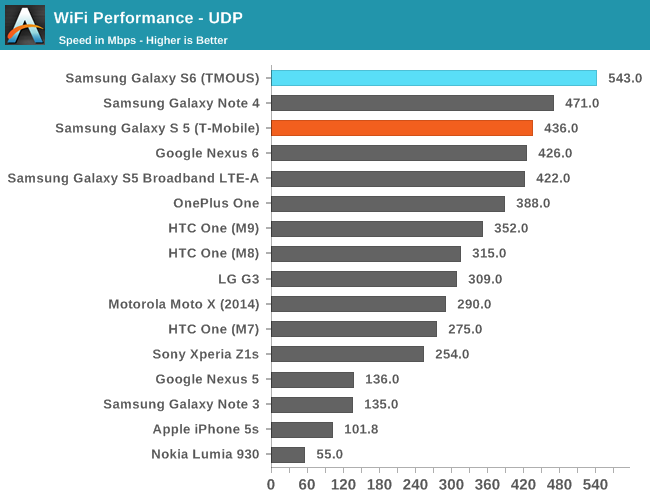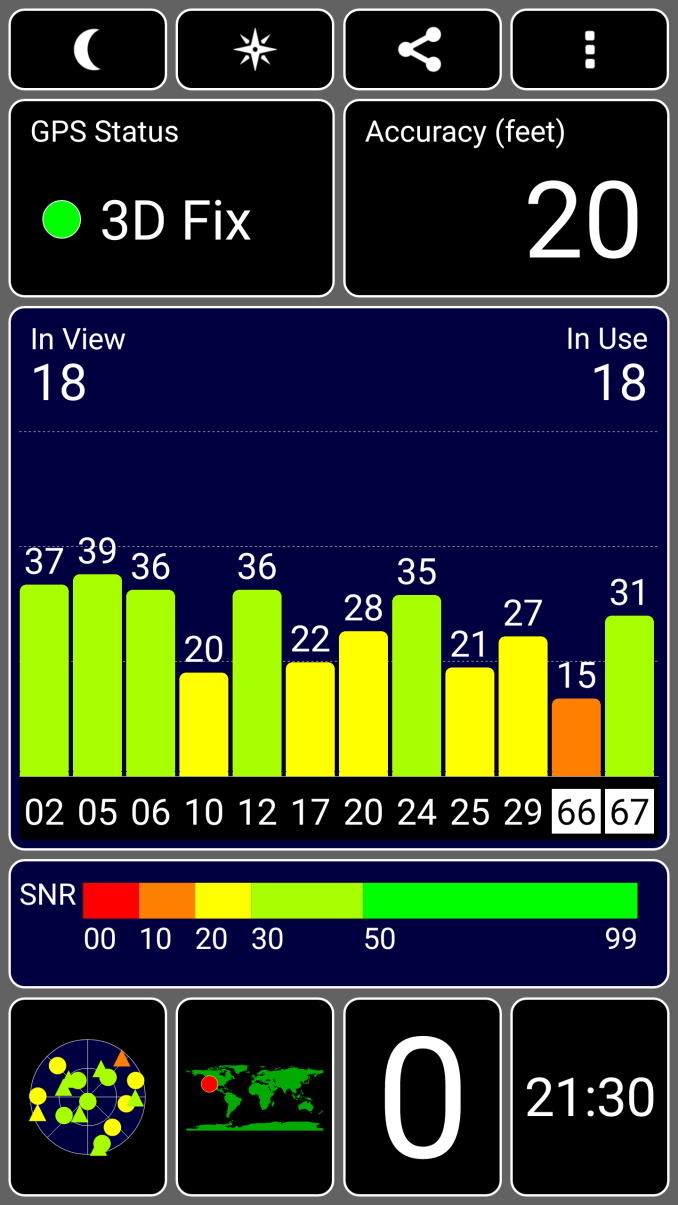The Samsung Galaxy S6 and S6 edge Review
by Joshua Ho on April 17, 2015 9:00 AM EST- Posted in
- Smartphones
- Samsung
- Mobile
- Galaxy S6
- Galaxy S6 Edge
WiFi Performance
As WiFi is still quite important on a smartphone for anyone on a relatively limited data plan, it's also important to test how well a device behaves when using WiFi. In order to do this, we use our standard iperf test to see how fast the device can send UDP packets. In the case of the Galaxy S6, we see that it shares the same BCM4358 WiFi/Bluetooth combo chipset that we first saw in the Galaxy Note 4. As always, in order to ensure maximum possible performance we're using an Asus RT-AC68U router to avoid issues with the router bottlenecking the phone.

As we can see, the Galaxy S6 manages to do better than anything else we've been able to test in recent memory. I'm not sure what's causing the difference in performance when comparing against the Note 4, but it's definitely possible that the antenna configuration has been improved to increase coherence and therefore the performance benefit that comes from MIMO.
GNSS Performance
In most of the Galaxy S6 variants, as there is no Gobi modem that could be used to provide GNSS location services it seems that Samsung has turned to Broadcom to provide satellite location services. In the case of the Galaxy S6, we see a Broadcom BCM4773 location chipset. This includes support for all of the major constellations including GPS, Beidou, and GLONASS in addition to SBAS, which helps to improve accuracy beyond what conventional GPS satellites can provide. To get a good idea for how good this system is I tried testing how long it took for a lock to happen on a clear night with airplane mode on. The Galaxy S6 managed to acquire a lock in 20 seconds which is likely to be a warm lock but a cold lock will likely take a minute without assistance data. After an additional 20 seconds I saw a peak accuracy of 20 feet, so there shouldn't be any notable issues with the GPS system. For the Galaxy S6 CDMA variants it's likely that location will be done using the MDM9x35 Gobi modem rather than the Broadcom solution used in the GSM Galaxy S6.
Misc
For the Galaxy S6, Samsung has fundamentally uprooted how they traditionally design their phones, and in the case of the entire radio architecture this is especially true. Instead of the standard Qualcomm modem, we see that Samsung has moved to the Shannon 333 GSM/LTE modem for the Galaxy S6 GSM variants. Given that this is likely to be the same modem that is in the Note 4 LTE-A it’s likely that this modem will ship as category 6, while we have reason to believe it's ultimately capable of UE category 9. However, whether the RF front-end is capable of handling 3x carrier aggregation of up to 450 Mbps on the downlink is a different question and is likely to be one that we won’t know the answer to unless support is added in an OTA update.
The transceiver, envelope tracker, antenna tuner, and most of the components that would traditionally be Qualcomm parts in a Snapdragon-equipped phone have also been replaced with Samsung Shannon components based upon the Chipworks teardown. In general though, I didn’t notice any issues with this choice of RF components although judging by the use of Qualcomm modems in the CDMA variants it’s likely that such a move was necessary in order to ensure good RF performance on CDMA networks but not GSM networks due to Qualcomm’s experience with CDMA2000. It's likely that anyone that has had previous experience with the CDMA Galaxy Nexus would be able to attest to this.
Unlike some other variants, we’ve noticed that the Galaxy S6 T-Mobile variant uses an Audience eS804 voice processor to enable hot word detection and S-Voice launching and is likely also active in phone calls and in any other scenario where noise cancellation and voice processing would be beneficial. The T-Mobile variant that we received also uses an NXP PN547 NFC module rather than a Samsung NFC module, but we did confirm that there is an ST-M digitizer used for the touchscreen and a Cypress CapSense PSoC for the capacitive keys.
Although I still don’t have the equipment to test speakers properly, subjectively the audio quality of the Galaxy S6’s single downward-firing speaker is good. The volume gets high enough that I never really used it on maximum volume for videos, but it’s still annoying to have to cup my hand to ensure that sound is going towards my face rather than traveling away. Overall the M9 still has much better speakers for a good media experience, but there’s nothing wrong with the speaker on the Galaxy S6 for casual use. I definitely found myself using it less than the front-facing speakers on the M9 though.











306 Comments
View All Comments
JeffFlanagan - Friday, April 17, 2015 - link
I agree that the lack of a removable battery will be a problem for some people, but I don't know how big a segment of the market that is. We'll find out how well Samsung understands their market over the next couple of months when we see how well the S6 sells.FlushedBubblyJock - Friday, April 24, 2015 - link
and one of the 1st reports is the selling aka pre orders have been inflated and only 2/3rds have panned out - so the sales are droopy...http://www.androidauthority.com/samsung-galaxy-s6-...
So they are crap. Oh well, appleheads will be very pleased.
Anand321 - Saturday, April 18, 2015 - link
SOlution is simple!!Carry a power bank and whenever battery is down, charge it in 1/2 hour.
They also have wireless charging option, which you can use. There are wireless charging power bank also in the market.
So instead of buying a 2nd battery and always carrying it, carry a power bank. Thats enough.
But one thing...this phone lasts more than 7-8 hours even after continuous heavy usage!!
FlushedBubblyJock - Friday, April 24, 2015 - link
I love the feel of toting around that extra large battery powerbank and having the wireless charger doohickie plugged in as an add on wherever I need it, it just adds to the feel when I stroke my metal industrial design and take some personal touch moments with it in my hand.Anand321 - Saturday, April 18, 2015 - link
Also taking care of the fact, that a phone is hardly used after 2/3 years, that extra battery will be of now use after you change your phone. But with wireless charging and such wireless power banks, you dont have to spend money on battery every 2 year!!Makes sense..ain't it!!
opx4real - Friday, April 17, 2015 - link
So...you clearly didn't make it all the way to the memory page before you just HAD to voice your knee jerk reaction.darkich - Saturday, April 18, 2015 - link
While the ask if SD support is technically a functional downgrade, people tend to forget that Samsung is in turn offering the most advanced internal storage that offers unprecedented speed and uncompromising performance.And I'd say that's a fair trade.
darkich - Saturday, April 18, 2015 - link
*while the lack of SD support *FlushedBubblyJock - Friday, April 24, 2015 - link
while others tend to forget an sd card slot could be included too, thus there would be no trade off, just a massive improvementjuxt417 - Wednesday, April 22, 2015 - link
It has nothing to do with being more iPhone like. An SD card would lag horribly when loading and taking those beautiful 4k pictures it is capable of producing. Not to mention it would cause lag throughout the u.i. and cause unnecessary power drain.